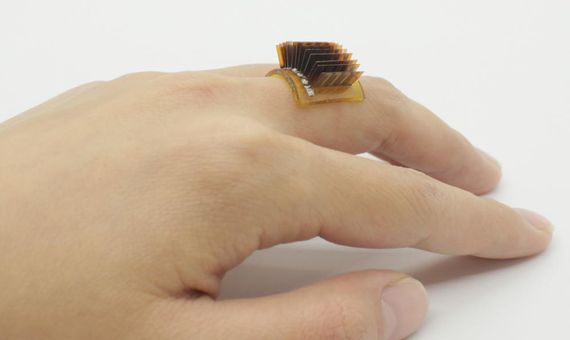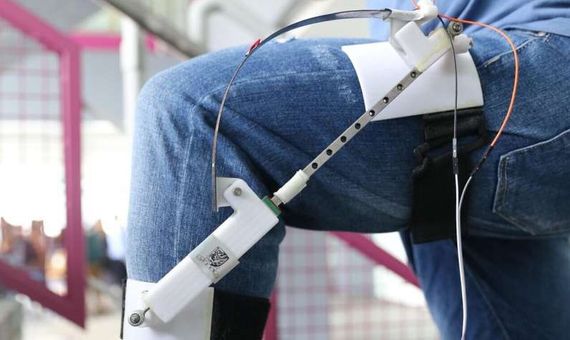If you close your eyes in a quiet place, you will begin to feel the cadence of your breathing, the beating of your heart, the pulse in your wrists. All these phenomena tell you that you are alive, but they are also an example of wasted energy. In a perfect world, the human body could become a source of renewable energy in which our breathing, our heartbeat, our movements and even the flow of blood through our arteries could be harnessed by tiny power plants.
For years, scientists around the world have been working to build such power plants, using special materials that are sometimes shrunk to nanometre size. The goal, they say, is to create a new generation of devices that can use the body’s energy to power pacemakers, diabetic alert systems and many other devices that would measure vital signs in real time without using any more electricity than our bodies can generate. Some researchers are building systems that can even harvest energy from our movements to charge a GPS or mobile phone.
Nanotechnology to harness our energy
“The energy available in our body by physiological processes is a thousand times greater than that required to power some small electronic devices,” explains Xudong Wang, a professor at the University of Wisconsin in Madison and an expert in piezoelectric materials, the name given to certain solid materials such as crystals or some ceramics that generate electricity when they are deformed. Wang designed a kind of miniature windmill consisting of a thin strip of a piezoelectric material that, when vibrated by the passage of air, like that produced by breathing, generates small currents. “This and similar devices are capable of generating tens of microwatts, sufficient to move small electronic devices such as sensors or implants to measure blood glucose, blood pressure or to monitor the heart,” adds Wang.

In recent years, the nano-materials engineer and his team have developed a bandage that applies electrical pulses to accelerate wound healing, and is powered by the energy produced by the rib cage as it expands and contracts during breathing. They have also invented a wireless patch that harnesses the energy from random body movements to promote hair growth through small electric pulses. Wang is applying this electrical stimulation of cellular activity for regenerative purposes to the creation of implants that can act inside the body, for example to help mend broken bones, and then be reabsorbed without a trace. It is a technology, he says, that “is feasible today.”
Transforming heartbeats into electricity
So far, devices have been developed that can generate electricity from the movement of limbs, which is quite obvious, but also from biochemical phenomena such as the oxidation of glucose or the electrical potential generated in the inner ear when sounds enter. The most difficult yet was achieved by the team of Rolf Vogel, professor of cardiovascular engineering at the University of Bern: a vascular turbine, a system that extracts energy from the flow of blood through an artery to generate enough electricity to power a cardiac pacemaker.
In today’s pacemakers, the battery has to be replaced every eight to ten years, which requires surgery. Researchers are therefore working on systems that can harness the body’s energy to power these devices in a maintenance-free way. The blood turbines tested by Vogel and other groups are one option, but it is also possible to convert the heartbeat itself into electricity.

At the University of Illinois, materials physicist and chemist John Rogers created a chip made of nano-sized layers of lead zirconate titanate, a piezoelectric material that generates electricity with each heartbeat and sends it to a small battery where it is stored. The whole thing is mounted onto a silicon layer that is implanted directly into the heart. Although other similar technologies exist, Rogers’ team was the first to test it on large animals such as cows, pigs and sheep, demonstrating that it generated the necessary energy and did not cause rejection problems. In Bern, Vogel is testing a device with the same purpose, which harnesses the movement of the heart and transforms it into electricity by electromagnetic induction, just as the pickups of an electric guitar do with the vibration of the strings.
Human body, energy and technological innovation
The decisive step for such technologies will be to apply them to humans. Implants such as these must pass clinical trials in patients, which can take years and is when many such innovations fail. Other times they are simply too expensive to bring to fruition. In order to be able to undertake these trials with certain guarantees, researchers are also developing systems to test implants in pre-clinical phases and in a fully controlled manner, such as a robotic platform that mimics the motions of the heart.
It is therefore difficult to predict which of these devices will eventually reach the commercial market and what their specific applications will be. They may end up being more popular in consumer electronics than in medical electronics since clinical trials are not required. Wearable technologies, devices for external use to monitor health parameters, are strong candidates to take advantage of these new forms of energy.

For the time being, systems capable of harvesting body energy to power external devices have already been in experimental application for years. In London, tests have been carried out at Heathrow Airport and on Oxford Street with pavements that generate electricity from the footsteps of pedestrians. One such development by Xudong Wang was installed at a high-traffic site at the University of Wisconsin. At the Chinese University of Hong Kong, the team led by engineer Wei-Hsin Liao has created a device that captures biomechanical energy from the motion of the knee while walking to generate electricity to charge a GPS or other wearables. Not only mechanical energy, but also body heat is seen as a resource for producing electricity to power wearable technologies or devices connected to the Internet of Things.
“It is very difficult to predict, but in 20 years I think the barrier between consumer and medical electronics will disappear,” says Ernest Mendoza, from the nanomaterials group at the Polytechnic University of Catalonia. The expert believes that the major impediment to this type of device is that, for now, they are too expensive. This will change as soon as a large consumer electronics company decides to seriously invest in this field, something that companies such as Apple are already tentatively doing.
There will be devices powered by your body’s energy that will measure pulse rate, heart rhythm or information relating to a particular ailment such as diabetes. “We will have real-time information on our state of health thanks to this type of device and you will no longer go to the doctor when you feel ill, but rather when the device tells you to go,” concludes Mendoza. Some experts predict a future in which we will establish a bioelectronic closed circuit between our body, energy capture systems and our electronic devices and medical implants—a symbiosis between body and electronics that will turn us into true renewable power plants.
Comments on this publication